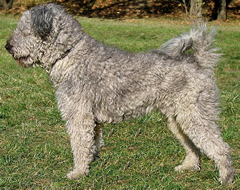|
The Canine Chronicles Directory
Pumi

The Pumi is a small to medium-sized dog with Terrier characteristics. This breed
has an elongated muzzle that is long and narrow. The nose is narrow and is always
black. The eyes are oval-shaped and are dark brown in color. The ears are v-shaped,
set high and carried upright with the top third bending forward. The neck is the
same length as the head. The Pumi is very lean and has taut muscles. The tail is
set high and is carried in an open circle above the back. They have fur similar
to that of the Puli puppy, but does not form cords. It is wavy or curly and grows
to be about one to three inches long. Solid colors include white, black, fawn and
shades of grey.
|
|
Temperament
|
The Pumi is alert, loving, fun and energetic. They seem to be restless, always on
alert and looking for action. The breed is very, very vocal and makes excellent
watch and guard dogs. They are daring, excited and spirited. This dog has a true
Terrier spirit and enjoys being active. Some in this breed can be quick to anger
and may bite if provoked. They get along better with older children and with other
pets if they are raised with them. They need an owner who has time to train, socialize
and exercise them.
|
|
Height, Weight
|
Male Height: 16-19" ; Weight: 22-33 lbs.
Female Height: 15-18" ; Weight: 17-28 lbs.
|
|
Health Problems
|
The Pumi is occasionally prone to hip dysplasia and patellar luxation.
|
|
Living Conditions
|
This breed should have a yard with lots of running room.
|
|
Exercise
|
The Pumi is extremely energetic and needs plenty of vigorous exercise. This Terrier-type
should receive enough exercise as well as mental challenges.
|
|
Life Expectancy
|
About 12-13 years
|
|
Grooming
|
The coat of this breed needs to be brushed or combed daily to prevent matting.
|
|
Origin
|
The Pumi was created during the 17th and 18th centuries in Hungary by crossing the
Puli with the German and French Terrier-type breeds with prick ears. They have been
used for over 300 years as a herder of sheep, pigs and cattle. They are also great
hunters of vermin. After WWII, the Pumi diminished and was on the brink of extinction.
A breeder by the name of Emil Raitsits brought the breed back and no longer crossed
the breed with the Puli. It was recognized as a separate breed during the 1920s.
They are recognized by the FCI and the UKC, and have been accepted for recording
in the AKC Foundation Stock Service®.
|
|
Group
|
Herding
|